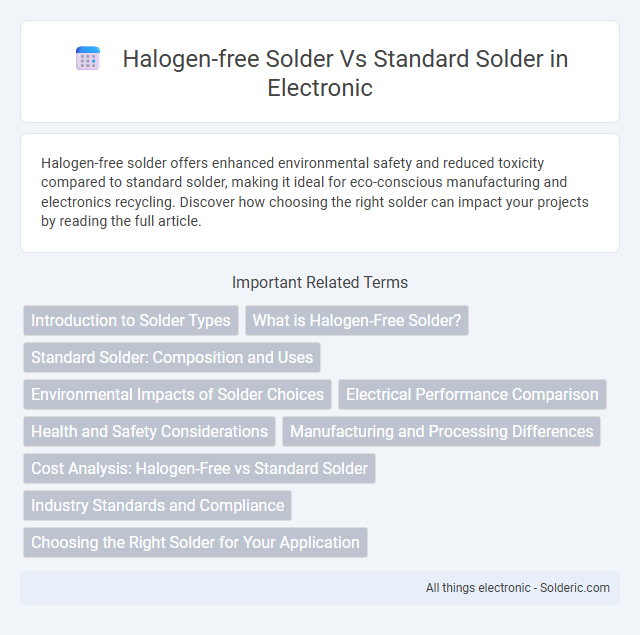Halogen-free solder offers enhanced environmental safety and reduced toxicity compared to standard solder, making it ideal for eco-conscious manufacturing and electronics recycling. Discover how choosing the right solder can impact your projects by reading the full article.
Comparison Table
| Feature | Halogen-Free Solder | Standard Solder |
|---|---|---|
| Composition | Lead-free, no halogens (bromine, chlorine) | Often contains lead, may include halogens |
| Environmental Impact | Eco-friendly, reduced toxic emissions | Higher environmental toxicity due to halogens and lead |
| Health & Safety | Lower health risks, non-toxic fumes | Potentially toxic fumes; lead exposure risk |
| Thermal Performance | Comparable melting point, sometimes higher | Consistent melting points; widely tested |
| Reliability | Good joint strength, less corrosive | Proven reliability, possible corrosion from halogens |
| Cost | Higher due to specialized materials | Generally lower cost |
| Use Case | Environmental compliance, green electronics | Standard electronics manufacturing |
Introduction to Solder Types
Halogen-free solder eliminates harmful halogen compounds found in standard solder, making it an eco-friendly choice for electronics manufacturing. This type of solder reduces the release of toxic gases during soldering, enhancing workplace safety and environmental compliance. You can improve product sustainability and meet strict regulatory standards by selecting halogen-free solder over traditional options.
What is Halogen-Free Solder?
Halogen-free solder is a type of solder alloy formulated without halogen elements such as bromine and chlorine, reducing toxic emissions and environmental impact during soldering processes. This solder is commonly used in electronics manufacturing to meet strict environmental regulations like RoHS and WEEE, which limit hazardous substances. Compared to standard solder, halogen-free solder enhances workplace safety and promotes sustainability while maintaining reliable electrical connections.
Standard Solder: Composition and Uses
Standard solder typically contains a combination of lead and tin, often with added flux to facilitate melting and bonding. It is widely used in electronics for creating reliable electrical connections due to its excellent conductivity and relatively low melting point. Your choice of solder depends on the application, but standard solder remains popular for general-purpose circuit board assembly despite increasing environmental concerns over lead content.
Environmental Impacts of Solder Choices
Halogen-free solder significantly reduces environmental hazards by eliminating harmful halogen compounds that can produce toxic dioxins and furans during disposal or incineration, unlike standard solder which often contains these substances. The use of halogen-free solder supports safer recycling processes and minimizes hazardous waste in electronic manufacturing and end-of-life treatment. Choosing halogen-free solder aligns with stringent international environmental regulations such as RoHS and WEEE directives, promoting sustainability in electronics production.
Electrical Performance Comparison
Halogen-free solder offers improved electrical performance with lower ionic contamination, reducing the risk of circuit corrosion and enhancing long-term reliability in sensitive electronic applications. Standard solder typically contains halogens, which can increase the potential for electrical leakage and failure under high humidity conditions, impacting your device's durability. Choosing halogen-free solder ensures better conductivity stability and safer operation in advanced electronic assemblies.
Health and Safety Considerations
Halogen-free solder significantly reduces exposure to toxic fumes compared to standard solder, enhancing workplace air quality and minimizing respiratory risks. Your health benefits from lower emissions of harmful substances like dioxins and furans that are commonly released during soldering with halogen-containing materials. This safer alternative supports compliance with stringent environmental and safety regulations in electronics manufacturing.
Manufacturing and Processing Differences
Halogen-free solder typically requires higher processing temperatures compared to standard solder due to its unique alloy composition, which enhances its environmental compliance during manufacturing. The absence of halogen compounds reduces corrosive byproducts, necessitating specialized flux formulations to ensure optimal wetting and solder joint quality. Manufacturers must adapt reflow profiles and select compatible materials to accommodate the thermal stability and chemical characteristics of halogen-free solder in assembly lines.
Cost Analysis: Halogen-Free vs Standard Solder
Halogen-free solder typically incurs higher material and manufacturing costs compared to standard solder due to the use of eco-friendly, non-toxic compounds that require specialized processing. Standard solder benefits from widespread availability and established production methods, resulting in lower price points and broader market adoption. Your choice between halogen-free and standard solder impacts overall budget considerations, especially when factoring in regulatory compliance and environmental sustainability goals that may justify the initial cost premium.
Industry Standards and Compliance
Halogen-free solder complies with stringent industry standards such as IPC-4101B and IEC 61249-2-21, ensuring reduced environmental and health hazards by eliminating halogen content. Standard solder typically follows IPC J-STD-006 requirements but may contain halogens, which can lead to corrosive byproducts and stricter disposal regulations. Your choice of Halogen-free solder aligns with RoHS and REACH compliance, supporting sustainable manufacturing and safer electronics assembly.
Choosing the Right Solder for Your Application
Halogen-free solder offers a safer alternative to standard solder by eliminating toxic halogens, making it ideal for environmentally sensitive applications and complying with strict regulations. Standard solder, typically containing lead or halogenated fluxes, provides strong mechanical bonds and excellent electrical conductivity, suited for general-purpose electronics where environmental factors are less critical. Choosing the right solder depends on your application's requirements for safety, performance, and regulatory compliance, ensuring reliability while minimizing health and environmental risks.
Halogen-free solder vs standard solder Infographic

 solderic.com
solderic.com